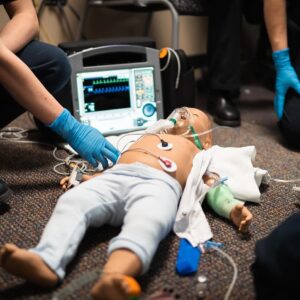
Paramedic Training Class 50: Navigating Pediatric Emergencies
The students of Paramedic Training Class 50 are halfway through their 10-month training program and are immersed in completing drills, diagnosing and formulating treatment plans, and developing critical decision-making skills about patient resuscitations. They are able to start IVs, perform endotracheal intubations, manage cardiac arrest patients, and care for pediatric patients, including childbirth emergencies.
Last month, the students began a series of pediatric drills that provide extensive opportunities to practice their medical skills and knowledge on infants and children, some of the most vulnerable patients. Although rare, emergencies involving children and infants can be very intense. They have unique medical needs, their anatomy differs from adults, and they often can’t communicate what’s wrong. Thanks to a grant to the Medic One Foundation, students now have the opportunity to practice their lifesaving skills on high-fidelity pediatric manikins. With these new manikins, they can practice establishing secure airways, starting intravenous lines, removing foreign body airway obstructions, performing chest compressions, and much more.
Over the course of three months, students will participate in multiple simulation drills where they will put their skills to the test, assessing and treating mock infants and children suffering from a range of illnesses and traumas, like respiratory distress, cardiac arrests, head trauma, drownings, and more. At the end of the series, students will participate in a final drill where they will be graded and evaluated on the total patient care process for pediatric patients.
These drills, which are critical to the successful training and education of our region’s paramedics, would not be possible without the support of our donors.